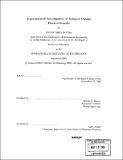Experimental investigation of induced-charge electro-osmosis
Author(s)
Levitan, Jeremy Asher, 1977-
DownloadFull printable version (10.97Mb)
Alternative title
Experimental investigation of ICEO
Other Contributors
Massachusetts Institute of Technology. Dept. of Mechanical Engineering.
Advisor
Martin Z. Bazant.
Terms of use
Metadata
Show full item recordAbstract
We analyze the general phenomenon of induced-charge electro-osmosis (ICEO), nonlinear electro-osmotic slip generated when an electric field acts on its own induced charge around a polarizable surface, in the context of microfluidics. Simple ICEO flows are first observed around a platinum wire in a polymer microchannel. While convenient for scaling analysis of resulting flows, this geometry proved difficult to analyze because of sensitivity to measurement height. This motivated the development of microfabrication techniques for the creation of electroplated metal structures with clean surfaces for ICEO flow characterization. ICEO flows are analyzed in a simple geometry, with an electroplated metal cylinder and two outer electrodes on a glass substrate. ICEO flow velocities scale as V2, where V is the potential drop across the outer electrodes, and decay monotonically with increasing frequency. Flow velocity also decays with increasing electrolyte concentration. Fixed-potential ICEO, with non-zero fixed charge on the polarizable surface, is demonstrated around a metal cylinder. A range of electrolyte solutions are tested in ICEO flow geometries and measured velocities scale well with effective salt diffusivity. Finally, we propose ICEO microfluidic systems as solid-state pumps and mixers for a variety of possible applications. (cont.) A range of electrolyte solutions are tested in ICEO flow geometries and measured velocities scale well with effective salt diffusivity. Finally, we propose ICEO microfluidic systems as solid-state pumps and mixers for a variety of possible applications.
Description
Thesis (Ph. D.)--Massachusetts Institute of Technology, Dept. of Mechanical Engineering, 2005. Includes bibliographical references (leaves 103-107).
Date issued
2005Department
Massachusetts Institute of Technology. Department of Mechanical EngineeringPublisher
Massachusetts Institute of Technology
Keywords
Mechanical Engineering.